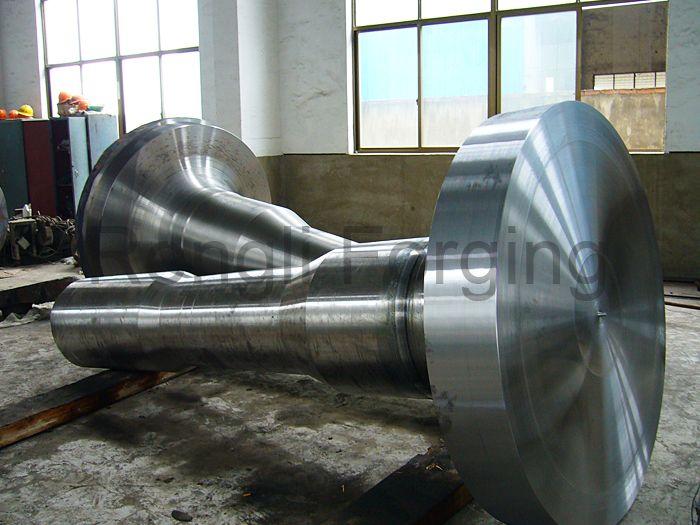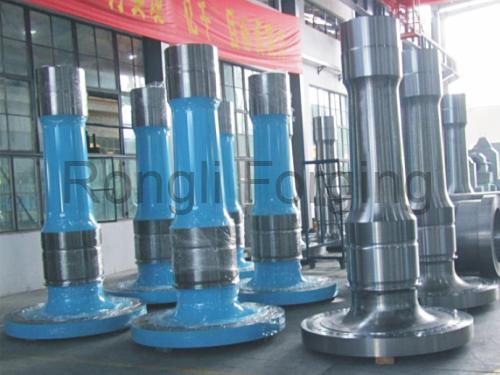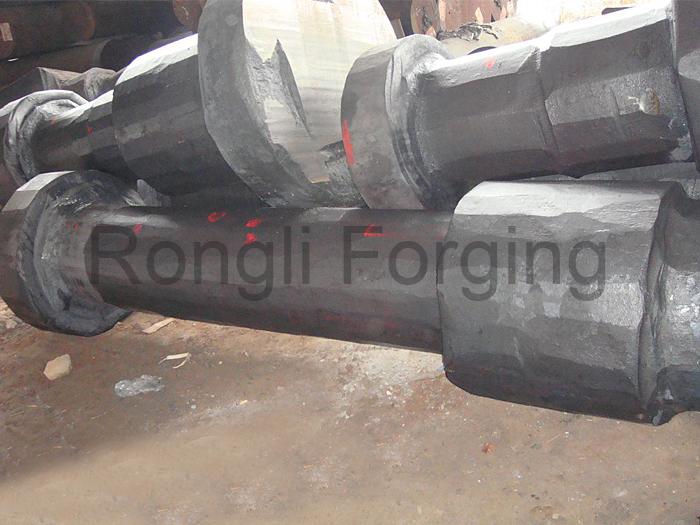
Open die forging wind turbine shafts significantly enhance performance in wind energy applications. The process, often referred to as open die forging also called free die forging, allows manufacturers to create large, high-strength components essential for turbine assemblies. I find it impressive that this method is projected to represent nearly 49% of the wind turbine forging market by 2025. The superior mechanical properties and excellent grain structure of these best open die forging wind turbine shafts ensure they withstand high fatigue, making them ideal for both onshore and offshore projects. As the demand for larger rotor diameters and extended hub heights grows, the advantages of China open die forging wind turbine shafts become increasingly clear. Additionally, understanding the open die forging wind turbine shaft price is crucial for manufacturers looking to invest in this technology.
Key Takeaways
- Open die forging improves the strength and reliability of wind turbine shafts, leading to longer-lasting components that require less maintenance.
- This method allows for precision and customization, enabling manufacturers to create tailored designs that meet specific performance needs.
- Open die forging is cost-efficient, resulting in lower lifecycle costs due to reduced replacements and minimal material waste.
- The enhanced performance of open die forged shafts under stress ensures they can withstand harsh environmental conditions, making them ideal for wind energy applications.
- Sustainability is a key benefit, as open die forging utilizes recycled materials and optimizes energy consumption, contributing to a smaller carbon footprint.
Improved Material Properties of Open Die Forging Wind Turbine Shafts
Open die forging wind turbine shafts offer remarkable improvements in material properties. This process refines the grain structure of the metal, which eliminates internal defects. As a result, I find that these shafts exhibit enhanced strength and reliability. This improvement leads to longer-lasting components that require less maintenance.
The table below illustrates how open die forging compares to other methods in terms of fatigue resistance and toughness:
| Forging Method | Fatigue Resistance | Toughness |
|---|---|---|
| Open-die Forging | Superior | Enhanced |
| Closed-die Forging | N/A | N/A |
| Casting | N/A | N/A |
From my experience, the superior fatigue resistance of open die forged shafts is crucial for wind turbines. These components endure constant stress from wind forces, making durability essential. The enhanced toughness also allows these shafts to withstand sudden impacts without failure.
Moreover, the microstructural changes that occur during the forging process are significant. The hot-deformation process optimizes the microstructure, which not only enhances strength but also allows for thinner wall sections. This reduction in weight can lead to improved efficiency in turbine operation.
Precision and Customization in Open Die Forging Wind Turbine Shafts

Open die forging wind turbine shafts excel in precision and customization, making them ideal for various applications. This method allows manufacturers to create components tailored to specific requirements. I find it fascinating that open die forging can accommodate custom dimensions and complex geometries. This flexibility is particularly beneficial for large-scale shafts and flanges used in wind turbine applications.
Here are some key advantages of precision and customization in open die forging:
- Tailored Designs: Manufacturers can incorporate specific design features that meet performance and durability standards.
- Material Utilization: The process allows for better material utilization, reducing waste during production.
- Versatile Applications: Open die forging can produce components for both onshore and offshore wind turbines.
While open die forging offers significant customization, it does have some trade-offs. For instance, the dimensional accuracy of open die forged shafts is lower compared to precision forging. This means that open die forging often requires more subsequent machining to meet precise specifications. Precision forging, on the other hand, minimizes the need for machining by producing parts close to their final shape.
The tolerances typically achieved in open die forging of wind turbine shafts are as follows:
| Tolerance Standard | Description |
|---|---|
| ISO 286-2 | H11-H13 |
| Surface Quality | ISO 8501-1 Sa2.5 |
These tolerances impact shaft performance, as they determine how well the components fit together and function under stress. Despite the need for additional machining, the ability to customize designs makes open die forging a valuable option in the wind energy sector.
Cost Efficiency of Open Die Forging Wind Turbine Shafts
Cost efficiency is a critical factor when evaluating manufacturing methods for wind turbine shafts. I have found that open die forging offers significant advantages over alternative processes. This method excels in producing large, custom-shaped components with superior mechanical properties. These features are especially beneficial for high-capacity wind turbines.
When comparing open die forging to other methods, I noticed distinct differences in cost and performance. For instance, closed die forging provides precision and minimal material wastage, making it suitable for medium-sized shafts. Seamless rolled ring forging produces high-strength components valued in offshore applications. However, open die forging stands out for its ability to create robust shafts tailored to specific needs.
To illustrate the lifecycle costs, I compiled a comparison between forged and machined shafts:
| Shaft Type | Forged | Machined |
|---|---|---|
| Material | 42CrMo4 (forged) | AISI 1045 (machined) |
| Diameter | 600 mm | 600 mm |
| Fatigue Cycles (Before Crack) | >10 million | <4 million |
| Cost (Lifecycle, 20 years) | $45,000 | $60,000 (due to replacements) |
The data shows that open die forged shafts not only last longer but also save money over time. The reduced need for replacements contributes to lower lifecycle costs.
Another advantage of open die forging is the minimal material waste generated during production. I found that this process results in very little material waste compared to impression die forging and other methods, which typically produce higher waste levels. This efficiency not only reduces costs but also supports sustainability efforts in the industry.
Enhanced Performance Under Stress of Open Die Forging Wind Turbine Shafts

Open die forging wind turbine shafts demonstrate exceptional performance under stress. I have observed that these shafts endure the demanding conditions typical in wind energy applications. The forging process enhances their strength and durability, making them ideal for critical components in wind turbines.
The table below summarizes how open die forged components contribute to the overall reliability of wind energy systems:
| Evidence Description | Key Benefits |
|---|---|
| Forgings for component parts and seamless rolled rings have a greater lifespan than other products due to their strength and durability. | Ideal for critical components requiring high tensile strength, enhancing overall system reliability. |
| Open die forged parts and seamless rolled rings are used because they have superior properties and can endure the harsh environment and stresses present in these settings. | Enhanced durability and resistance to environmental factors such as high temperatures and abrasives. |
| Open die forgings and seamless rolled rings are essential components in the wind energy sector, contributing to the overall reliability and efficiency of turbines. | Greater lifespan and reduced likelihood of cracking or warping, ensuring reliability in critical components. |
From my experience, the ability of open die forged shafts to withstand high stress levels is crucial. These components face constant forces from wind and mechanical loads. The superior mechanical properties of these shafts allow them to maintain integrity even under extreme conditions.
Moreover, the microstructural enhancements achieved during the forging process lead to improved fatigue resistance. This means that open die forging wind turbine shafts can endure more cycles of stress without failure. I find this particularly important for offshore wind turbines, where environmental factors can be harsh and unpredictable.
Sustainability Benefits of Open Die Forging Wind Turbine Shafts
Sustainability plays a vital role in the manufacturing of open die forging wind turbine shafts. I have observed that manufacturers are increasingly adopting eco-friendly practices in their production processes. This shift not only benefits the environment but also enhances the overall efficiency of wind energy systems.
Here are some key sustainability benefits I find noteworthy:
- Use of Recycled Materials: Many manufacturers now utilize recycled steel in their forging processes. This practice reduces the demand for new raw materials and conserves natural resources.
- Optimized Energy Consumption: The energy consumption during the forging process is being optimized. This means that manufacturers are finding ways to produce high-quality shafts while using less energy.
- Circular Economy Principles: Implementing circular economy principles encourages designs that allow for easy refurbishment or recycling at the end of a product’s operational life. This approach minimizes waste and promotes sustainability.
Recycling forged wind turbine shafts recovers valuable materials and reduces waste that ends up in landfills. I find it impressive that using recycled materials often requires less energy than producing new ones from raw materials. This not only lowers production costs but also contributes to a smaller carbon footprint.
Moreover, sustainable forging practices, such as closed-loop water systems and hydrogen-based heat treatment, further reduce the carbon footprint associated with production. For instance, companies like Bharat Forge are now supplying forgings utilizing Green Steel, reinforcing their commitment to sustainability.
Open die forging plays a crucial role in the wind energy sector. I have seen firsthand how this method provides high-performance shafts that meet industry demands for durability, efficiency, and sustainability. The ability to manufacture larger and more complex shapes is essential for wind turbine components.
According to industry reports, the market for open die forging is expected to reach 1.0 billion USD by 2024, driven by the increasing demand for renewable energy sources. This growth highlights the importance of innovative manufacturing processes to meet rising global energy requirements.
In my experience, the flexibility in shape and mechanical strength of open die forging wind turbine shafts ensures they can endure high torsional and bending loads. As the industry continues to evolve, I believe that open die forging will remain a key player in advancing wind energy technology.
FAQ
What is open die forging?
Open die forging is a manufacturing process that shapes metal using large dies. I find this method ideal for producing high-strength components like wind turbine shafts. It allows for customization and enhances material properties.
How does open die forging improve shaft performance?
I have observed that open die forging refines the grain structure of the metal. This process enhances strength, durability, and fatigue resistance, making the shafts more reliable under stress in wind energy applications.
What materials are used in open die forging?
Manufacturers often use carbon steel, alloy steel, and stainless steel for open die forging. I appreciate the versatility of these materials, as they can be tailored to meet specific industry standards and customer requirements.
How does open die forging contribute to sustainability?
Open die forging supports sustainability by utilizing recycled materials and optimizing energy consumption. I find that these practices reduce waste and lower the carbon footprint associated with producing wind turbine shafts.
What are the typical dimensions of open die forged shafts?
Open die forged shafts can reach lengths of up to 20 meters (66 feet) and weigh as much as 70 tons (44,000 lbs). This capability allows manufacturers to create large components essential for wind turbine assemblies.
Post time: Sep-22-2025




